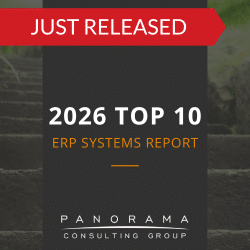As global supply chains become increasingly complex, businesses are under pressure to streamline their operations, minimize costs, and maintain control over inventory. Unfortunately, legacy systems and manual processes can’t accomplish this.
Using modern supply chain technology or a modern ERP system for inventory management is now essential – not just for cost-cutting but for real-time visibility, improved operational efficiency, and more informed decision-making.
Today, we’re exploring the benefits of ERP in inventory management, especially when it comes to inventory control.
The 2026 Top 10 ERP Systems Report
What vendors are you considering for your ERP implementation? This list is a helpful starting point.
The Benefits of ERP for Inventory Management and Control
Implementing an ERP system for inventory management can help you automate routine tasks, ensure data consistency across departments, streamline inventory control, and more.
1. Real-Time Visibility and Data-Driven Decision Making
One of the key benefits of ERP in inventory management is real-time visibility across the supply chain. This means businesses can accurately track inventory levels, shipments, and demand forecasts to inform decision-making.
Many companies adopt ERP inventory management systems to increase customer satisfaction by ensuring accurate stock availability and faster delivery times.
How Does it Work?
ERP systems consolidate data from procurement, production, sales, and other functions to provide a holistic view of operations. Many ERP vendors take this a step further by providing advanced forecasting capabilities that use historical data, market trends, and predictive analytics to anticipate future demand.
When our ERP consulting company helps clients evaluate advanced analytics capabilities, we consider their corporate objectives and the key performance indicators (KPIs) they will need to track to support those objectives. This helps inform some of the software requirements we share with potential vendors.
(Learn about the latest advanced analytics trends.)
2. Automation and Error Reduction
Manual processes in inventory management are prone to human error. An ERP system reduces these risks by automating tasks such as data entry, order processing, and stock adjustments.
How Does it Work?
One of the most valuable ERP functionalities is automated purchase order generation. When stock falls below predefined thresholds, the system automatically creates purchase orders and sends them directly to approved suppliers.
Some vendors offer IoT integration for this function, allowing companies to use IoT sensors to monitor stock levels, environmental conditions, and item movements. IoT data feeds directly into the ERP, updating inventory tracking systems automatically and reducing the need for manual cycle counting.
3. Scalability and Flexibility
Most of the top ERP systems provide the scalability businesses need to manage inventory effectively as they grow. Whether expanding into new markets, expanding product lines, or adding additional warehouses, companies can use ERP solutions to support more complex operations.
How Does it Work?
Many ERP systems offer industry-specific features and multi-location management, allowing businesses to optimize stock levels and improve logistics across multiple sites.
In addition, warehouse management tools help businesses maintain control over inventory without adding complexity or overhead costs.
4. Inventory Optimization and Cost Efficiency
ERP systems can reduce holding costs by helping businesses align stock levels with actual demand. For example, by enabling just-in-time inventory, companies can minimize excess stock, reducing storage costs and obsolescence risks.
Additionally, ERP systems optimize procurement with automated reordering from suppliers and providing the data visibility that businesses need to negotiate better terms with vendors.
How Does it Work?
Demand planning algorithms can analyze historical sales data, predict future inventory needs, and automate reorder points.
In addition, ERP systems integrate with supplier management tools to provide real-time visibility into supplier performance, lead times, and pricing trends.
5. Enhanced Risk Management and Compliance
Industries with stringent regulatory requirements, such as pharmaceuticals or food and beverage, can benefit from ERP’s ability to track inventory from production through to sale.
Furthermore, ERP solutions track product lifecycles and expiration dates, reducing the risk of holding obsolete or non-compliant stock.
How Does it Work?
ERP systems feature real-time tracking, automated audit trails, and regulatory compliance tools, such as FDA validation and lot tracking.
In addition, these systems use workflow automation to generate compliance reports and send alerts for expiring stock.
Strategic Recommendations for CEOs
While the benefits of ERP in inventory management are clear, successful implementation is challenging. CEOs and senior executives need to consider several strategic factors to ensure the ERP system reaches its full potential.
1. Prioritize Change Management
Implementing an ERP system is a major organizational change, so companies should engage stakeholders early, while communicating the benefits of the system and investing in end-user training.
Our change management consultants often tell clients that an end-user training strategy is an integral part of a change management plan. By providing opportunities for end-users to learn new skills and technologies, you minimize fear and increase the resonance of your communication.
2. Focus on Data Accuracy
An ERP system is only as good as the data it relies on. Bad data can cause miscalculations in reorder points, costly expedited shipping fees to replenish stock, and delayed customer deliveries.
We recommend ensuring that existing inventory data is clean and accurate. Ongoing data governance is also necessary to maintain the integrity of the system.
For example, a manufacturing firm might conduct a full audit of its inventory records, identifying inaccuracies, duplicate entries, and outdated information. By cleaning and standardizing this data, the company can ensure that the ERP system enables reliable demand forecasting, better production planning, and smoother coordination between manufacturing plants and warehouses.
3. Select a Scalable Solution
For many organizations, ERP selection is a rushed three-ring circus full of bias.
We recommend selecting a solution based on your specific business needs, including future business needs. Typically, this means prioritizing scalability and flexibility.
Look for a solution that can adapt to changing business needs, whether that involves adding new product lines, expanding to new markets, or adopting new technologies, like artificial intelligence.
For example, a healthcare organization might select an ERP system with built-in machine learning capabilities to ensure that it can adopt AI-driven predictive analytics in the future. Selecting the right solution would enable the organization to eventually harness capabilities such as automated patient demand forecasting and predictive expiration management.
Optimize Your Inventory Management Processes
Implementing an ERP system for inventory management can improve inventory accuracy, enhance the customer experience, and streamline time-consuming manual tasks.
However, technology alone won’t deliver these benefits. Your employees must be prepared for change, and your data must be ready for showtime.
Learn how to prepare for a successful ERP implementation by contacting our independent ERP consultants today.














